Setifis

Setifis (or "Sitifis") was a Roman colonia in western Mauretania Caesariensis. It was called Colonia Nerviana Augusta Martialis Veteranorum Sitifensium and was located near Roman Saldae and actual Bona (Algeria).[1] Now the city is called Sétif.
History
Setifis was founded by the Romans, during the reign of Nerva, as a colony for veterans. Although no buildings of this period are known, a cemetery excavated in the 1960s seems to have contained tombs from the early colony.[2]
The Romans built a circus at Sitifis, which aerial photographs show survived substantially intact until the 20th century; today only a small part of the curved end continues visible; the remainder has been destroyed or built over.
As the town grew, around 297 AD, the province of Mauretania Sitifensis was established, with Setifis as its capital. In the newly prosperous town a bath building was built, decorated with fine mosaics: its restoration in the fifth century had a cold room (frigidarium) paved with a large mosaic showing the birth of Venus.[3] On the northwest edge of the town two great Christian basilicas were built at the end of the fourth century, decorated, again, with splendid mosaics.[4] Probably Setifis was fully Christian in the fifth century.
Only a small part of the original Roman settlement has been uncovered. Probably the center of the colony was under the Byzantine citadel, where in the past the theater was discovered and where the forum must have been located. Only remains of houses have been found, W of the fortress at the very foot of the walls. Stratigraphic test pits indicate that they must be attributed to the end of the 1st c. A.D. These houses were themselves destroyed and covered with a layer of fill when a large temple was built in the second half of the 2d or beginning of the 3d c. The foundations of the cella and the peribolus of the temple have been brought to light....At the end of antiquity the town changed greatly....Very extensive walls enclosed the original town and the new districts. At the same time, public monuments were built (Circus) or restored (Amphitheater). Most of these constructions date to the second half of the 4th c., though some are of the period of the Tetrarchy....Houses and shops have been identified. Within a large, very damaged residence small hot baths happened to be preserved, with a mosaic depicting the Toilet of Venus. In this network of streets, in fact partially blocking the course of some of them, two Christian funerary basilicas were erected side by side. One was built before 378 (probably only a little before), the other before 389. These dates are provided by mosaic funerary inscriptions that formed the floors of the central and lateral naves. New inscriptions, dated by the provincial year, were put in regularly until 429, with one text from 471.Inside the town, inscriptions and older excavations reveal the existence of other cult sites as well as public monuments: the amphitheater restored about 297 and again under Julian, a temple to the Magna Mater restored in 288, a water tower (still visible) where the town aqueduct ended. Outside the walls, N of the town, a hippodrome has now been found....The walls are over 5,000 m long.Perseus [5]
Although we do not know what happened under Vandal rule, the Byzantine reconquest brought with it a major fort, of which parts are still standing. In 647 AD, the first Muslim expedition to Africa took place. By 700 AD, the area had been conquered and converted to the Islamic faith. Setifis was destroyed and Christianity seems to have disappeared since then in the area.
We know little of the early Islamic town, but by the tenth century the area outside of the fortress was once more filled with houses: on the site of the Roman baths over twelve of these were excavated, with large courtyards surrounded by long, thin, rooms.[6] In the mid-eleventh century this development stopped abruptly, and a defensive wall was built around the city. The historian Leo Africanus reports that a major wave of destruction followed the invasion of the Banu Hillal shortly thereafter. Nothing more is known of Sétif until the ruins of the town were used by the French army, who built their own fortress on the site in 1848, using the line of the medieval city wall and the Byzantine fortress.

Notes
- ↑ "Detailed map of Mauretania Caesariensis".
- ↑ R. Guéry, 1985, La Necropole orientale de Sitifis: fouilles de 1966-1967. Paris.
- ↑ E. Fentress, ed., Fouilles de Sétif 1977 - 1984 BAA supp. 5, Algiers, 29-92
- ↑ P.-A. Fevrier, Fouilles de Sétif: les basiliques chrétiennes du quartier nord-ouest Paris, 1965.
- ↑ Perseus: Setifis
- ↑ E. Fentress, ed., Fouilles de Sétif 1977 - 1984 BAA supp. 5, Algiers, 114-151
Bibliography
- Mommsen, Theodore. The Provinces of the Roman Empire Section: Roman Africa. (Leipzig 1865; London 1866; London: Macmillan 1909; reprint New York 1996) Barnes & Noble. New York, 1996
- Reynell Morell, John. Algeria: The Topography and History, Political, Social, and Natural, of French Africa. Publisher N. Cooke. London, 1854 ( )
See also
- Caesarea of Mauretania
- Icosium
- Saldae
- Romano-Berber states
- Regnum Maurorum et Romanorum
- Christian Berbers
%2C_Algeria_04966r.jpg)